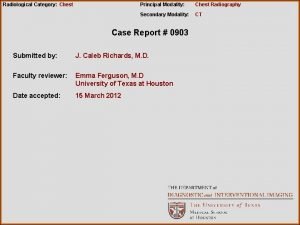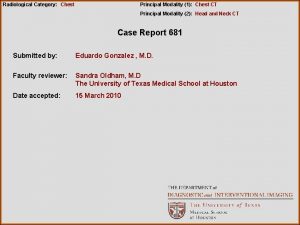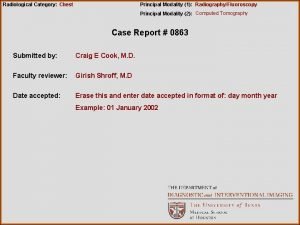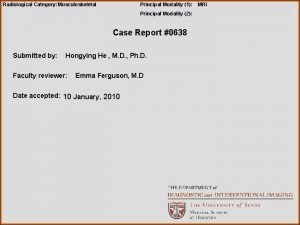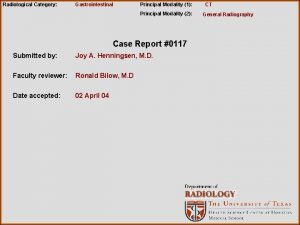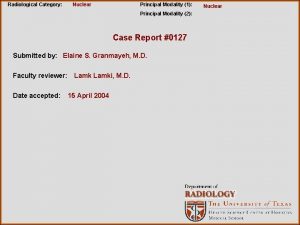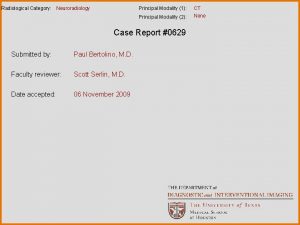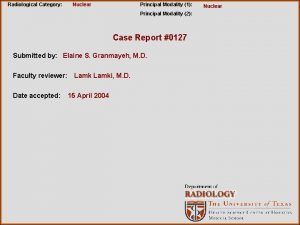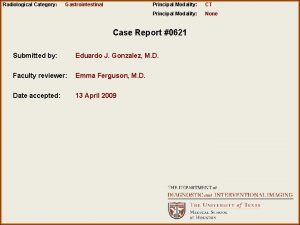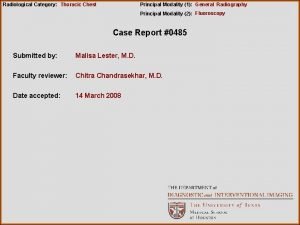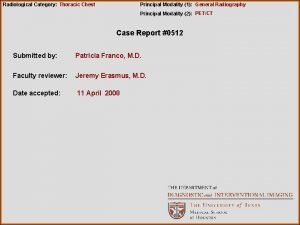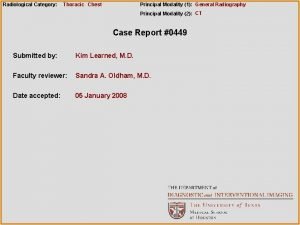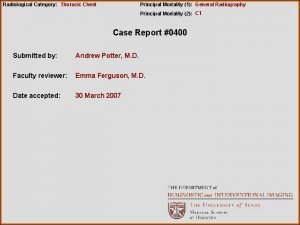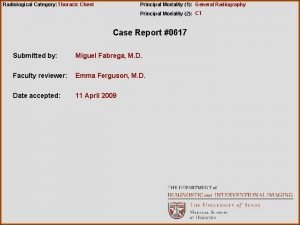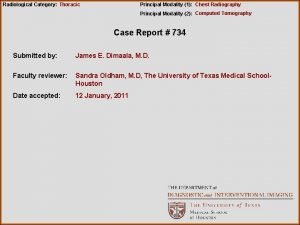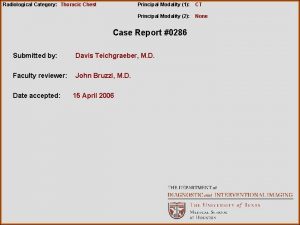Radiological Category Chest Principal Modality 1 CT Principal



















- Slides: 19

Radiological Category: Chest Principal Modality (1): CT Principal Modality (2): CR Case Report 697 Submitted by: Sireesha Yedururi, M. D. Faculty reviewer: Varaha S Tammisetti M. D The University of Texas Medical School at Houston Date accepted: 5 January 2010

Case History 21 year old male Hispanic patient. History is withheld

Radiological Presentations Imaging from 2006

Radiological Presentations Imaging from 2006

Radiological Presentations Imaging from 08/2006

Test Your Diagnosis Which one of the following is your choice for the appropriate diagnosis? After your selection, go to next page. • Septic emboli • Tuberculosis • Fungal infections (histoplasmosis, cocciodiomycosis, cryptococcosis, aspergillomas) • Wegeners ganulomatosis • Sarcoidosis • Juvenile laryngeal papillomatosis • Metastasis

Findings: Findings and Differentials Imaging from 2006: Chest 2 views : Consolidation in the superior segment of the left lower lobe and two cavitary lesions in the left perihilar region. Lateral view of the neck: Multiple soft tissue masses within the lumen of the infraglottic trachea. Axial neck CT with contrast: Mildly enhancing intraluminal masses within the larynx trachea along with irregular and nodular laryngeal wall. Axial chest CT with contrast in lung windows: Multiple thin walled cavitary lesions bilaterally and a dense consolidation in the superior segment of the left lower lobe. Differentials: • Intrapulmonary spread of recurrent respiratory papillomatosis • Multifocal cavitating pneumonia/septic emboli • Tuberculosis • Bronchogenic carcinoma in the left lower lobe with lung metastasis • Cavitary metastasis • Fungal pneumonia • Wegener's granulomatosis • Sarcoidosis • Lymphoma

Discussion Intrapulmonary spread of recurrent respiratory papillomatosis is considered high in the DD in view of intraluminal masses within the trachea and multiple cavitary lesions in the lung. The dense consolidation in the apical segment of left lower lobe is presumed to represent superimposed secondary infections including long standing bacterial pneumonia, TB, fungal infection. In addition, this patient gives history of recurrent respiratory papillomatosis since childhood and bronchoscopy revealed multiple laryngeal papillomas in the past. Tracheal involvement of tuberculosis is very rare. However, superimposed infection with mycobacterial was also considered in the differential diagnosis. Similarly, fungal infections were also considered in the differential diagnosis. Cavitary lesions are very rare with sarcoidosis and lymphoma. Cavitary metastasis and Wegener’s granulomatosis are considered less likely given the history of recurrent laryngeal papillomatosis since childhood. A primary lung lesion in the left lower lobe with cavitary metastasis is considered less likely in view of patients young age.

Additional History • History of recurrent respiratory papillomatosis with 200 + micro debridement surgeries since age 5 years. He presented to our hospital initially in July 2006 for increasing shortness of breath and hoarseness. He underwent recurrent bronchoscopic debridement in 2006. The patient represented again in 2009 for worsening symptoms and right sided pleuritic chest pain.

Radiological Presentations Imaging from 07/2009

Radiological Presentations Imaging from 07/2009

Radiological Presentations Imaging from 10/2009

Radiological Presentations Imaging from 10/2009

Findings: Findings and Differentials Imaging from 2009: Chest 2 views from 07/2009 : Marked progression of the previously identified nodular and cavitary lesions in the lungs since 2006. Persistent consolidation in the left lower lobe. Chest CT with contrast from 07/2009: Confirms the findings markedly progressing nodular/mass like and cavitary lesions since 2006. A new large cavitary lesion in right upper lobe. Chest CT with contrast from 10/2009: The right upper lobe cavitary lesion has resolved. Persistent left lower lobe cavitary lesion with thick and irregular walls. Bony erosion and destruction of the left T 4 vertebral body, lamina and pedicle and left fourth rib is new since 07/2009. A small enhancing epidural soft tissue component is also present at this level. Differentials: • Malignant transformation of recurrent respiratory papillomatosis lesion in the left lower lobe • Aggressive infection of the left lower lobe eroding the adjacent vertebrae and ribs. • Tuberculosis

Discussion Malignant transformation of the recurrent respiratory papilloma lesion in the left lower lobe is considered highly likely in view of the bone destructive changes in the adjacent rib and thoracic spine along with intraspinal extension of the tumor. A long standing increasing consolidation in the left lower lobe since 2006 most likely represents a chronic respiratory papilloma with recent transformation into a very aggressive neoplasm. Pulmonary tuberculosis and other aggressive pulmonary infections eroding the adjacent vertebral body and ribs with intraspinal extension is possible but considered less likely in a non immunocompromised patient. The patient underwent CT guided biopsy of the left lung mass and T 4 vertebral body. Both the biopsy results are consistent with squamous cell carcinoma.

Discussion • Recurrent respiratory papillomatosis (RRP) is a chronic disease caused by human papilloma virus (HPV) types 6, 11 and occurs in both children and adults. • Two forms of RRP are generally recognized: a more aggressive form that typically occurs in children and a less aggressive form that typically occurs in adults. Younger age at diagnosis is associated with more aggressive disease. • RRP is usually a benign disease involving the larynx (vocal folds) and often self limited disease. However, the clinical course is highly unpredictable with prolonged disease, multiple recurrences, extralaryngeal spread to the oral cavity, trachea, and bronchi and esophagus (~30% of children and 16% of adults) and malignant transformation. • Pulmonary RRP does not regress spontaneously unlike laryngeal papillomatosis and carries poor prognosis. • Clinical course of pulmonary RRP is insidious and may progress over years but eventually manifests as respiratory failure caused by destruction of lung parenchyma. • Radiologic findings in pulmonary papillomatosis: Multiple well-defined, round, “slow-growing” solid or cystic nodules with thick or thin walls are identified. Distal bronchial obstruction by large pulmonary papillomas result in obstructive radiologic findings including atelectasis, pneumonia, abscess, or bronchiectasis.

Discussion • Malignant transformation of the pulmonary RRP is very rare and very few cases have been reported so far. • Malignant transformation when it occurs determines poor prognosis, making early detection important. • Majority of the malignant lesions are squamous cell carcinomas, but adenosquamous transformation is also reported. • Because of the increased risk of carcinoma, any change in CT appearance of pulmonary lesions requires biopsy to rule out malignancy. An isolated case report suggested FDG-PET in pulmonary RRP did not help differentiate benign papillomas from malignancy. • Infection with HPV type 11 accounts for nearly all cases of malignant transformation of “pulmonary” RRP. Therefore, HPV genotyping may affect prognosis and therapy.

Diagnosis Malignant transformation of pulmonary parenchymal recurrent respiratory papillomatosis lesion. Teaching Point: Malignant transformation should be suspected in a persistent but progressive cavitary mass in a patient with recurrent respiratory papillomatosis to result in prompt and aggressive treatment/management.

References Derkay CS, Wiatrak B. Recurrent respiratory papillomatosis: a review. Laryngoscope. 2008, Jul; 118(7): 1236– 1247, 2008 Cook JR, Hill DA, Humphrey PA, Pfeifer JD, El-Mofty SK. Squamous cell carcinoma arising in recurrent respiratory papillomatosis with pulmonary involvement: emerging common pattern of clinical features and human papillomavirus serotype association. Mod Pathol. 2000 Aug: (13): 914 -8 Gimenez A, Franquet T, Prats R, Estrada P, Villalba J, Bague S. Unusual primary lung tumors: a radiologic-pathologic overview. Radiographics. 2002 May-Jun: 22 (3): 601 -19 Pipavath SN, Manchanda V, Lewis DH, Scmidt RA, Martins RG, Goodwin JD. 18 F FDG PET/CT findings in recurrent respiratory papillomatosis. Ann Nucl Med. 2008 Jun; 22(5): 433 -6. Epub 2008 Jul 4 Donne AJ, Hampson L, Homer JJ, Hampson IN. The role of HPV type in Recurrent respiratory papillomatosis. Int J Pediatr Otorhinolaryngol. 2010 Jan; 74(1): 7 -14. Epub 2009 Oct 1.
 Erate category 1
Erate category 1 Tennessee division of radiological health
Tennessee division of radiological health Center for devices and radiological health
Center for devices and radiological health National radiological emergency preparedness conference
National radiological emergency preparedness conference Radiological dispersal device
Radiological dispersal device Data modeling fundamentals
Data modeling fundamentals Lexical vs auxiliary verbs
Lexical vs auxiliary verbs Medium modality
Medium modality Pacs modality workstation
Pacs modality workstation Short wave diathermy definition
Short wave diathermy definition Characteristics of sensory neurons
Characteristics of sensory neurons Modality
Modality Sodality vs modality
Sodality vs modality Crow's foot notation
Crow's foot notation Cardinality and modality
Cardinality and modality Cardinality and modality
Cardinality and modality Callendreasonlocaluserinitiated
Callendreasonlocaluserinitiated Epistemic modality
Epistemic modality Birads classification
Birads classification Modality statistics
Modality statistics




















